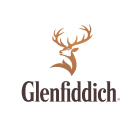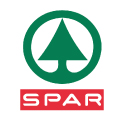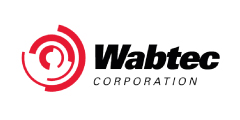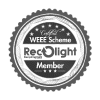Protecting Dark Skies in Modern Development

Balancing Light and Sustainability
As society advances toward green and sustainable energy goals, minimising environmental disruption becomes an increasingly vital priority. One important - yet often underestimated - aspect of this is the preservation of Dark Skies and Natural Buffer Zones, ensuring that humanity’s need for artificial lighting remains in harmony with the natural rhythms of the environment.
A significant contributor to light pollution is excessive Upward Light Output Ratio (ULOR) and Lux Spill, both of which can greatly compromise the environmental synergy of Sustainable Building Developments. These forms of obtrusive light not only degrade nocturnal ecosystems but also diminish the integrity of sustainable architectural practices.
While exterior lighting - typically installed for security or functional purposes - has direct and more predictable environmental implications, internal lighting often presents a more complex challenge. Light escaping through windows, doors, and rooflights can be difficult to measure and control, yet it contributes substantially to overall light pollution.
This issue poses a dilemma for building designers who aim to optimise natural daylighting as a strategy to improve thermal performance and reduce reliance on artificial lighting during daylight hours. Balancing the benefits of daylight with the need to protect night-time environments requires careful consideration of building orientation, glazing specifications, internal reflectivity, and shading strategies.
Lighting Strategies to Reduce Environmental Impact
Evaluate Visible Light Transmission (VLT)
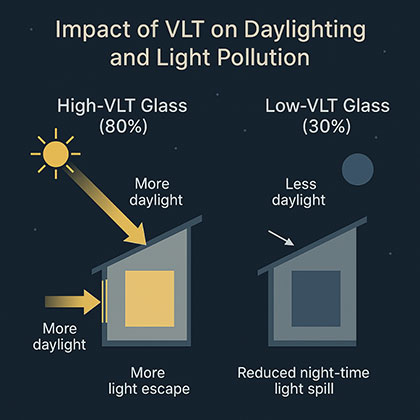
Visible Light Transmission (VLT) refers to the percentage of visible light (ranging from 0% to 100%) that passes through a material such as glass, plastic, or diffuser surfaces. While often associated with windows, skylights, solar tubes, and luminaires with diffusers, VLT plays a subtle yet significant role in environmentally-conscious lighting design - especially where ambient light and light trespass influence strategies for daylighting, energy efficiency, and glare control.
- High VLT (70–90%): Allows more visible light to pass through, resulting in brighter interior environments.
- Low VLT (10–40%): Indicates more shading or tinting, reducing both glare and solar heat gain.
In sustainable lighting applications, particularly those adjacent to sensitive zones such as County Wildlife Sites (CWS) or National Parks, the selection of VLT values must be handled with care. High-VLT glazed apertures can efficiently harvest natural light and contribute to passive solar gain - enhancing energy efficiency through reduced reliance on artificial lighting and improved thermal performance.
However, a higher VLT also allows more internal light to escape to the external environment, increasing the potential for light pollution and ecological disruption - particularly during nighttime hours.
To mitigate these impacts, eco-friendly lighting strategies often combine low to moderate VLT glazing materials with low-glare lighting fixtures. This dual approach enhances visual comfort indoors while limiting the amount of light that escapes through windows and other glazed surfaces at night.
Ultimately, VLT is not about the light source itself, but rather how light interacts with and passes through materials within the building envelope or lighting system. In environmentally-conscious design, VLT selection is a delicate balance: allowing sufficient transmission to support energy-saving and daylighting goals, while minimising obtrusive light and preserving the dark sky environment.
Select the Appropriate Lights
Exterior
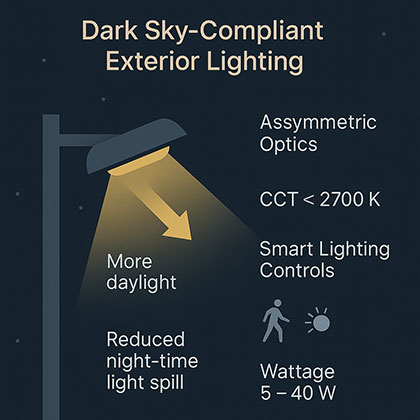
Exterior lighting is often the primary source of obtrusive light, particularly due to its proximity to environmentally sensitive areas such as wildlife corridors, dark sky zones, and buffer areas with minimal natural screening. Exterior installations are more exposed and, without proper lighting controls, can contribute significantly to Light Spill, Glare, and Skyglow.
To minimise environmental impact while still fulfilling functional lighting needs, luminaires should be carefully specified to match the intended use of the illuminated area - providing just enough light without excess. This balance is best achieved through:
- Low wattage systems tailored to the scale and purpose of the space.
- Asymmetric optics that direct light only where needed, avoiding upward or stray light.
- Smart lighting controls such as PIR sensors and photocells to dim or switch off lights when not required.
- Warm Correlated Colour Temperatures (CCT) below 2700K to reduce disruption to nocturnal wildlife and circadian rhythms.
Parameter | Recommended Value |
Wattage | 5W – 40W |
Correlated Colour Temp (CCT) | < 2700K (warm white) |
Lighting Controls | PIR and/or Photocell (motion/daylight sensors) |
Horizontal Lux Spill (at 0m) | ≤ 0.2 lux |
Vertical Lux Spill (at 2m) | ≤ 0.4 lux |
These values support dark sky compliance, help preserve nocturnal ecosystems, and promote overall environmental harmony—especially in developments near sensitive or protected sites.
Internal
While typically associated with comfort and functionality within buildings, internal lighting can be a significant indirect contributor to obtrusive light, particularly through light transmission via glazing - including windows, doors, and rooflights. In many cases, especially when overlooked during the design or planning stages, internal light spill can have greater environmental impact than external lighting.
This is especially relevant in buildings located near sensitive receptors such as nature reserves, rural areas, or dark sky zones, where even modest internal light levels can disrupt nocturnal habitats and ecosystems.
To mitigate internal light transmission, both lighting and building designers should incorporate the following strategies:
- Select luminaires with light distribution angles below 70° - This limits the spread of light towards vertical surfaces (e.g. windows), focusing illumination downward where it's needed.
- Position light fixtures away from glazed areas - Increasing the distance between luminaires and windows reduces the amount of direct light escaping to the outside environment.
- Use room layouts and finishes that reflect or absorb light internally - Orient lighting to direct illumination toward interior surfaces such as walls and floors. Materials with higher reflectance can help distribute light efficiently within the space while reducing the need for higher lumen outputs.
These measures collectively aim to focus light within the interior environment, avoiding unnecessary transmission through transparent surfaces. This not only supports eco-friendly lighting goals but also enhances energy efficiency and visual comfort.
Conclusion
Protecting dark skies is an essential yet often overlooked aspect of sustainable design. By managing both exterior and interior light emissions - through thoughtful material choices, smart technologies, and strategic fixture placement - we can reduce light pollution without compromising function. Sustainable development must illuminate responsibly, ensuring that progress on the ground doesn’t come at the cost of the stars above.






